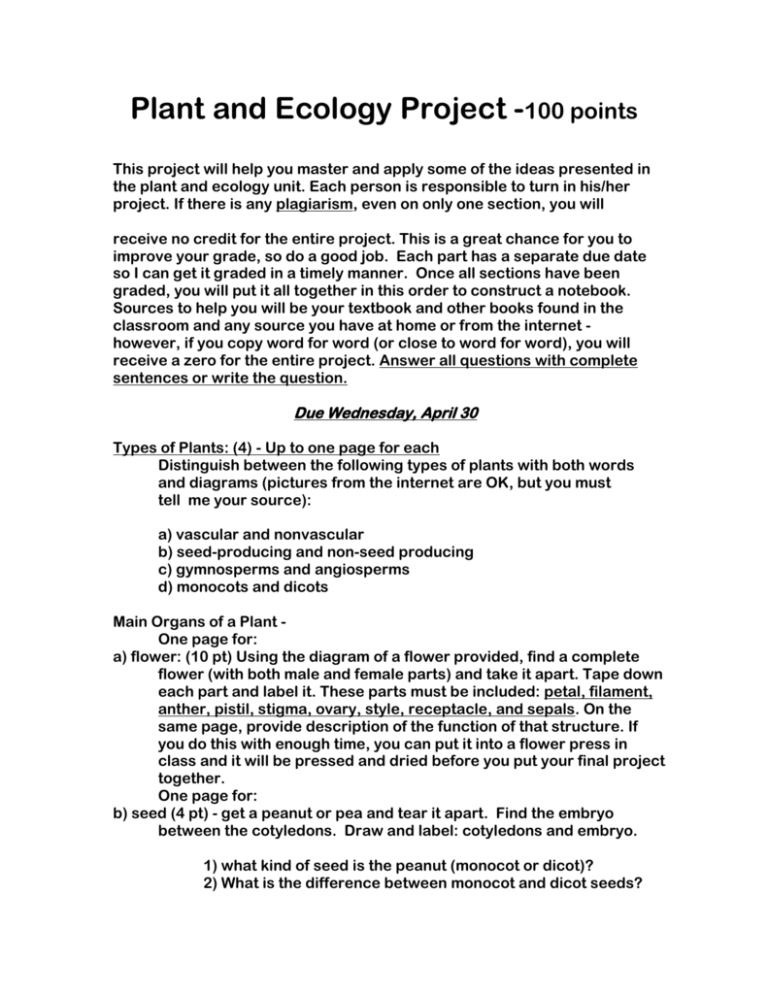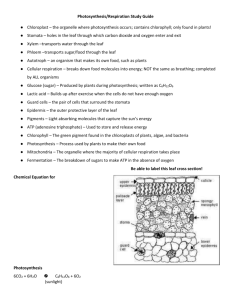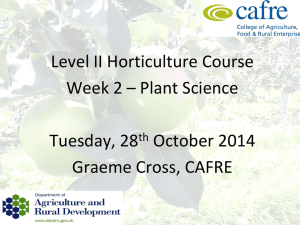Plant and Ecology Project
advertisement

Plant and Ecology Project -100 points This project will help you master and apply some of the ideas presented in the plant and ecology unit. Each person is responsible to turn in his/her project. If there is any plagiarism, even on only one section, you will receive no credit for the entire project. This is a great chance for you to improve your grade, so do a good job. Each part has a separate due date so I can get it graded in a timely manner. Once all sections have been graded, you will put it all together in this order to construct a notebook. Sources to help you will be your textbook and other books found in the classroom and any source you have at home or from the internet however, if you copy word for word (or close to word for word), you will receive a zero for the entire project. Answer all questions with complete sentences or write the question. Due Wednesday, April 30 Types of Plants: (4) - Up to one page for each Distinguish between the following types of plants with both words and diagrams (pictures from the internet are OK, but you must tell me your source): a) vascular and nonvascular b) seed-producing and non-seed producing c) gymnosperms and angiosperms d) monocots and dicots Main Organs of a Plant One page for: a) flower: (10 pt) Using the diagram of a flower provided, find a complete flower (with both male and female parts) and take it apart. Tape down each part and label it. These parts must be included: petal, filament, anther, pistil, stigma, ovary, style, receptacle, and sepals. On the same page, provide description of the function of that structure. If you do this with enough time, you can put it into a flower press in class and it will be pressed and dried before you put your final project together. One page for: b) seed (4 pt) - get a peanut or pea and tear it apart. Find the embryo between the cotyledons. Draw and label: cotyledons and embryo. 1) what kind of seed is the peanut (monocot or dicot)? 2) What is the difference between monocot and dicot seeds? Due Friday. May 2 One page for: c) ROOTS (4 pt) - find and look at the roots of a dandelion and grass (either in real life or in a book or on line. Answer the following: 1) What are the two main jobs of roots for plants? 2) What type of root systems do the dandelion and grass have? 3) What type of root system does a carrot have? 4) Why can dandelions survive the hot dry summer better than grass? One page for: d) STEMS (4 pt) - Find the two types of stems and tape a small example of each onto a piece of paper to be inserted into your project. Label them with which type each is. Answer these questions: 1) What two types of vascular tissue are found in stems? What does each of these tissues do? 2) When you buy lumber at Home Depot, which of these tissues are you buying? One page for each type of leaf e) Leaves (6 pt)Leaf Types: Find an example of each of the following leaf types: simple, compound palmate, compound pinnate and compound doubly pinnate. Tape each leaf to a piece of paper and label which type the leaf is. On each leaf, label the petiole, blade, and veins. Due Monday, May 5 One page for: Cross section of a leaf (8 pt)- Label and color the diagram of a leaf cross section that is provided. Give the functions of each of the labeled parts. Terms to use include: vein (contains xylem and phloem), cuticle, palisade mesophyll, spongy mesophyll, guard cells, stomates, epidermis and chloroplasts Separate pages for each specimen: Collect four different plant specimens (leaves and flowers should do) and tape it to the space on the sheets provided. Fill in the information about that plant in the spaces below the specimen. (8 pt) Due Wednesday, May 7 One page: Mysteries of Life questions concerning plants (6 pt) Remember - complete sentences! Answer these on a separate piece of paper, written neatly or typed. 1. What is the difference between deciduous and evergreen trees? 2. What happens within a leaf to make it change color in the fall? 3. What happens at the petiole to make leaves fall off the deciduous tree in the fall? 4. Leaves are green. Discuss the light wavelengths and cell parts that cause this. 5. Why is a PhiladelphiaPhillies cap red? (If you got the answer to question 4, then you should be able to answer this). 6. Along the same lines as questions 4&5, which light wavelength is the least used by green plants in photosynthesis? One page for: Photosynthesis and Respiration (7 pt) Read the description of photosynthesis in your notes and answer these questions (remember to use complete sentences or write each question): 1) write the equation for photosynthesis 2) Where in a plant does photosynthesis occur? 3. Write the equations for photosynthesis and aerobic respiration together and describe similarities and differences. 4) What is anaerobic respiration? 5. Write the equation for aerobic respiration. 6) List the three stages of respiration. 7) Compare the amount of energy (in the form of ATP) given off by anaerobic respiration compared with that of aerobic respiration. Due Monday, May 12 Several pages for: Ecology Puzzle (15 pt) Create an ecology puzzle (crossword, word search, word scramble, etc) using the following terms: biome, ecosystem, community, population, climax community, succession, biotic, abiotic, pioneer organism, cellulose, transpiration, alternation of generations, geotropism, phototropism, thigmotropism, hydrotropism, vascular plants, nonvascular plants, and photosynthesis. Regardless of which type of puzzle you make, you must include definitions of each term. In order to receive full credit, you need to include a blank puzzle with clues and a puzzle with the answers filled in. The following web sites will assist you in making a puzzle: http://puzzlemaker.school.discovery.com/chooseapuzzle.html http://kids.msfc.nasa.gov/Teachers/WordFindBuilder/PuzzleBuilder.html http://www.varietygames.com One page for: Construct a food web (9 pt) using plants and animals from the Pine Barrens of NJ - use the Field Guide to the Pine Barrens in class. Copy (tracing is OK) the organism and place it on a food web with other organisms. You must include (pay close attention to the direction of the arrows): 2 producers 3 first order consumers 2 second order consumers 2 third order consumers 1 decomposer/scavenger Constructing your Project: Cover Page (5 pt) Pictures, a title and your name to construct a nice cover. Table of Contents (5) - Create a table of contents using the heading of each page and provide page numbers. Citation page for Works Cited (5) - you must give credit for information that is not yours - include your textbook, any other book, and any internet sources you used. The entire project will be put together so you have a nice remembrance of this unit. There will be a plant test at the end of this unit, so pay attenion to what you are doing. This information is also fair game for the final exam, so keep your notebook to refer to when studying for the final. Name ________________________________ Plant Specimen - Tape down a sample of a plant (leaf and/or flower, or if it is not a flowering plant, use just leaves) Common name of the plant ___________________________ Circle all that apply for this plant: Vascular or Nonvascular Bryophyte/Fern/Gymnosperm/Angiosperm Monocot or Dicot Stem = Woody or Herbaceous Veins in leaves - parallel, pinnate, palmate Deciduous or Evergreen Leaf type - simple/compound pinnate/compound palmate/ compound doubly pinnate/ other Annual/biennial/perennial Reproduction? - spores/"naked seeds"/flowers







